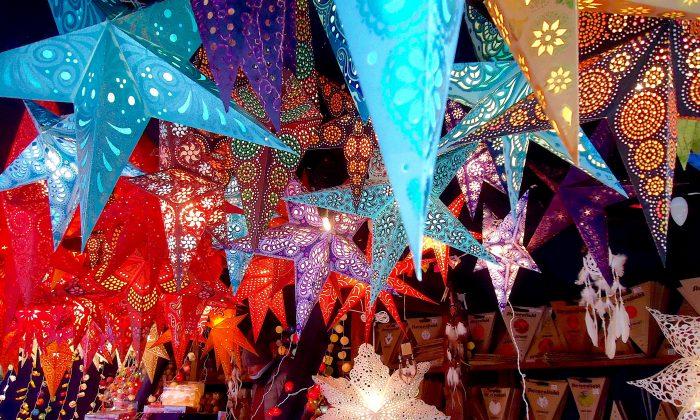Some sites in Paris never change—the Arc de Triomphe, the Eiffel Tower, the Louvre. But Paris also has a gypsy face where visiting shows and limited-run exhibitions travel to the city from all over the world and take up residence in its galleries and museums. Summer is the time when visitors to Paris can shop around for artistic marvels. And this summer the English, the Spanish, a classic French designer, and a sultry World War I spy named Mata Hari have staked out temporary territories.
At the Musée du Luxembourg, the 17th century palace that French queen Marie de' Medici once called home, the English royal house of Tudor is currently in residence. Until July 19, “The Tudors” showcases a collection of paintings, drawings, and book illuminations featuring Henry VII, Henry VIII, an assortment of Henry’s queens, and his unforgettable offspring, Edward VI, Mary I and Elizabeth I.
Nearby his sixth queen Kateryn Parr, wears the jeweled broach in the shape of a crown that Henry gave her as a wedding present. Elizabeth I, the lion’s cub, keeps a watchful eye from an inner room, a careful custodian of the legend of the Tudors.
If matching royal stares with some of England’s greatest royals gives you an appetite then help is at hand. In the museum’s courtyard is Angelina’s, a Paris eating institution known for its chocolate, pastries and sandwiches. Buy a sandwich or a slice of quiche and take it to the Luxembourg gardens around the corner. On my last visit the chestnut trees were all in blossom and the flower beds were packed with brilliantly coloured tulips. Parisians love al fresco meals under the trees in summer, which is probably why such scenes appear so often in French art.
From Art to Fashion
At the Grand Palais on the Right Bank, royalty dominates again with a major showing of paintings by 17th century Spanish artist Diego Velazquez, which runs until July 13. Velazquez’s entire career is on display in room after room of breath-catching work. From his early landscapes and religious pieces through his Italian experiments and insightful characterizations of the denizens of the Spanish court, the breadth of his work is outstanding.
Appointed as court artist by Spanish king Philip IV in 1624, Velazquez’s mastery of human character—particularly the portraits of the king’s ill-fated children set next to a sly courtier or the intense glare of Spain’s Grand Inquisitor—makes this exhibition one not to miss. You can enjoy a welcome time-out and a bite to eat at the café in the museum or take it outside under the light-shifting leaves of the chestnut trees.
For a completely different experience, the exhibition of the work of 20th century French fashion designer Jeanne Lanvin is on display at the Musée de la mode de la ville de Paris in the Palais Galliera just across the Seine from the Eiffel Tower. Running through Aug. 22, the lavish fabrics and intricately jeweled designs that made Lanvin’s luxe evening clothes a by-word in Parisian chic fill cases under soft lighting. Some of Lanvin’s notebooks are also on display, showing how fashion went from page to stage.
Among the highlights of the exhibition is a set of mother-daughter outfits that Lanvin created for herself and her young daughter—work that established her reputation as a designer. Lanvin was one of a coterie of gifted women like Coco Channel, Madeleine Cheruit, and Jeanne Paquin, who refashioned the world of fashion in the 20th century. Lanvin emphasized sweep and elegance and a fascination for the “little black dress.” Like the Tudors and the Hapsburgs of Spain, her clothes create a fantasy world all their own.
Mata Hari
And speaking of the world of fantasy, not far from Lanvin’s lavish creations the room where a Dutch-born, alleged World War I spy first performed in exotic dress under the stage name Mata Hari is now on exhibition at the Musée Guimet.
The founder of the museum, Emile Guimet, met the dark-eyed Margaretha Zelle at the turn of the 20th century and in 1905 arranged for her to perform a series of Indian temple dances in the library of his new museum. Under the name Mata Hari, Guimet passed off his Dutch protégée as an Indian princess from Java.
The choice of the sober museum library for the debut of Mata Hari still seems a strange one. Photos and film clips explain the performance, which is part of a larger exhibition titled “From No to Mata Hari, 2000 years of Asian Theater” running through Aug. 31. Ukioy-e woodblock prints from Japan showing a variety of 19th century actors in both male and female costumes are a fascinating complement to the notorious moves of Mata Hari.
The glorious Musée Guimet might be called the Asian Louvre as it houses the largest collection of Asian art in France. Its quiet galleries are a refuge for art lovers exhausted by the crowds jostling each other at the Musée d'Orsay or that other Louvre across town. Specializing in a wide variety of Asian art, from Shang Dynasty bronzes to Han funerary sculptures, from Tang terracottas to Khmer bodhisattvas, the museum also has a rich collection of art from the Silk Road complete with tiny stucco portrait heads of long-ago merchant traders who inhabited the oases from China to Persia.
Although neither the Palais Galliera nor the Musée Guimet have their own cafes, the chestnut trees are never far away and nearby brasseries are abundant. Order coffee at a sidewalk café or munch a croissant or coffee éclair on a bench along a shaded walk. The art of Paris is found not only in its museums and the brilliance of its summer exhibitions but by living well in a city that is itself a work of art.
Susan James is a freelance writer based in Los Angeles. She has lived in India, the U.K., and Hawaii, and writes about travel, art, and culture.




